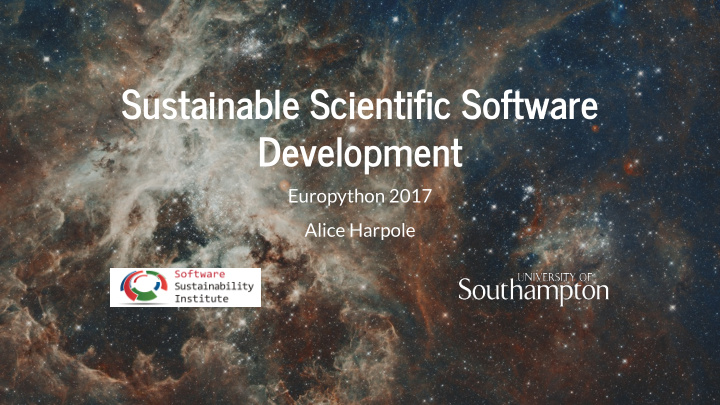



Sustainable Scientific Software Development Europython 2017 Alice Harpole
Motivation I model 'explosions in space' or: the effects of including general relativity in models of Type I X-ray bursts in neutron star oceans
Motivation Fed up of reading about exciting codes, only to find they're not open source they have next to no documentation questionable approaches to testing This is not good science!
Overview What is software sustainability (and why should I care)? Why scientific software is different Scientific software development workflow Version control Testing Continuous integration & code coverage Documentation Distribution Conclusions
What is software sustainability (and why should I care)? Will my code still work in 5/10/20 years' time? Can it be found? Can it be run? If not, harms future scientific progress
What makes scientific software different? Built to investigate complex , unknown phenomena Often developed over long periods of time Can involve lots of collaboration Built by scientists, not software engineers Turbulence modelled by Dedalus
The Scientific Method In experimental science, results are not trusted unless follow scientific method: testing of apparatus documentation of method Demonstrate experiment's results are accurate, reproducible and reliable
The Scientific Method In computational science, we are doing experiments with the computer as our apparatus We should also follow scientific method and not trust results from codes without proper testing or documentation
Source
PhD Comics
Development workflow Goal: implement sustainable practices throughout development Fortunately, there are lots of tools that will help us automate things!
Version control Keeps a log of all changes to code Computational science version of a lab book
Alexander Graham Bell's lab book - Wikimedia
Version control Aids collaboration - no overwriting each other's changes Can hack without fear - develop on a branch , so no danger of irreversibly breaking everything
Testing Should not trust results unless apparatus & method (i.e. the software) that produced them has been demonstrated to work any limitations (e.g. numerical error, algorithm choice) are understood and quantified
Testing Scientific codes can be hard to test as they are often complex investigate unknowns Does not mean we should give up!
Testing: Step 1 Break it down with unit tests Can't trust the sum if the parts don't work Makes testing complex codes more manageable Make sure these cover entire parameter space and check code breaks when it should
import unittest def squared(x): return x*x class test_units(unittest.TestCase): def test_squared(self): self.assertTrue(squared(-5) == 25) self.assertTrue(squared(1e5) == 1e10) self.assertRaises(TypeError, squared, "A string")
Testing: Step 2 Build it back up with integration tests Need to check all parts work together Can get more difficult here
Testing: Step 3 Monitor development with regression tests Check versions against each other Performance should improve (or at least not get worse) Bonus! Helps enforce backwards compatibility for users
Science-specific issues Unknown behaviour Use controls - simple input data with known solution Randomness isolate random parts test averages, check limits, conservation of physical quantities
data = rand(80,80) # declare some random data def func(a): # function to apply to data return a**2 * numpy.sin(a) output = func(data) # calculate & plot some function of random data plt.imshow(output); plt.colorbar(); plt.show()
Input is , so output must be 0 ≤ x ≤ 1 0 ≤ f ( x ) ≤ sin(1) ≃ 0.841 1 ⎯ ⎯⎯⎯⎯⎯⎯⎯ ⎯ f ( x ) = f ( x ) dx ≃ 0.223 ∫ 0 def test_limits(a): if numpy.all(a >= 0.) and numpy.all(a <= 0.842): return True return False def test_average(a): if numpy.isclose(numpy.average(a), 0.223, rtol=5.e-2): return True return False if test_limits(output): print('Function output within correct limits') else: print('Function output is not within correct limits') if test_average(output): print('Function output has correct average') else: print('Function output does not have correct average') Function output within correct limits Function output has correct average
Science-specific issues Simulations convergence tests - does accuracy of solution improve with order of algorithm used? if not, algorithm may not be implemented correctly Numerical error use numpy.isclose & numpy.allclose
# use trapezium rule to find integral of sin x between 0,1 hs = numpy.array([1. / (4. * 2.**n) for n in range(8)]) errors = numpy.zeros_like(hs) for i, h in enumerate(hs): xs = numpy.arange(0., 1.+h, h) ys = numpy.sin(xs) # use trapezium rule to approximate integral of sin(x) integral_approx = sum((xs[1:] - xs[:-1]) * 0.5 * (ys[1:] + ys[:-1])) errors[i] = -numpy.cos(1) + numpy.cos(0) - integral_approx plt.loglog(hs, errors, 'x', label='Error') plt.plot(hs, 0.1*hs**2, label=r'$h^2$') plt.xlabel(r'$h$'); plt.ylabel('error')
Continuous integration & code coverage Continuous integration tools regularly run tests for you & report back results Travis CI & CircleCI Find out when bugs occur much sooner - much easier to fix! Danger : outdated tests almost as useless as no tests If tests only cover 20% of code, why should you trust the other 80%? Code coverage ! Codecov
Documentation Ideal: someone else in your field should be able to set up and use your code without extra help from you Include comprehensive installation instructions Document the code itself (sensible function & variable names, comments) User guide with examples to demonstrate usage jupyter notebooks great for this Automate with Sphinx , host at Read the Docs
Distribution Make it findable Open source! (where possible) DOI e.g. from zenodo Reproducible results require a reproducible runtime environment package code in e.g. docker container, conda environment, PyPI Installation should be as painless as possible makefiles, try to limit reliance on non-open source libraries/material
Conclusions We need to future-proof our software Apply the scientific method to software development Only trust results from codes that are reproducible (open source!) tested documented Check out the SSI website www.software.ac.uk for more
Recommend
More recommend